As the nights draw in and the temperature drops, the thought of stepping outside into the garden may seem less inviting. Yet, there’s something special about enjoying the crisp air and the beauty of your garden year-round. So, how to keep your gazebo warm?
The gazebe, doesn’t have to be dormant during colder months. With the right strategies, it’s possible to retain the warmth in your gazebo and continue to make the most of this outdoor retreat, even in the chill of winter.
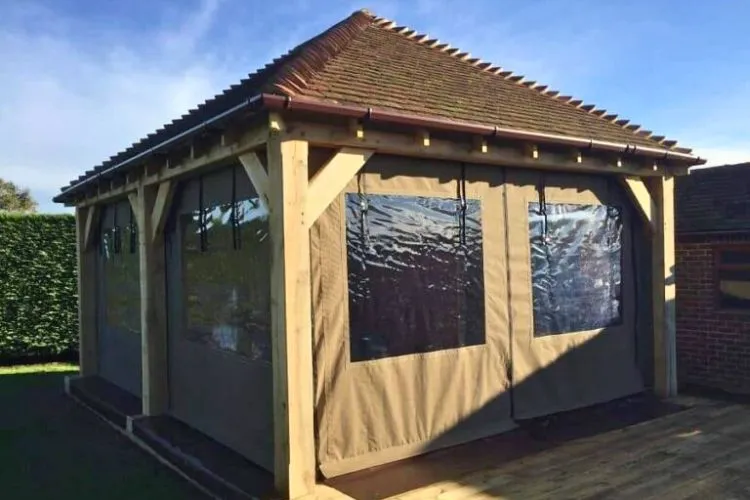
Contents
Understanding the Gazebo Structure
Insulation and Material Consideration
A gazebo’s ability to retain heat heavily depends on the materials used in its construction. Wood, with its natural insulating properties, tends to hold in heat better than metal. However, without proper insulation, wood can only do so much.
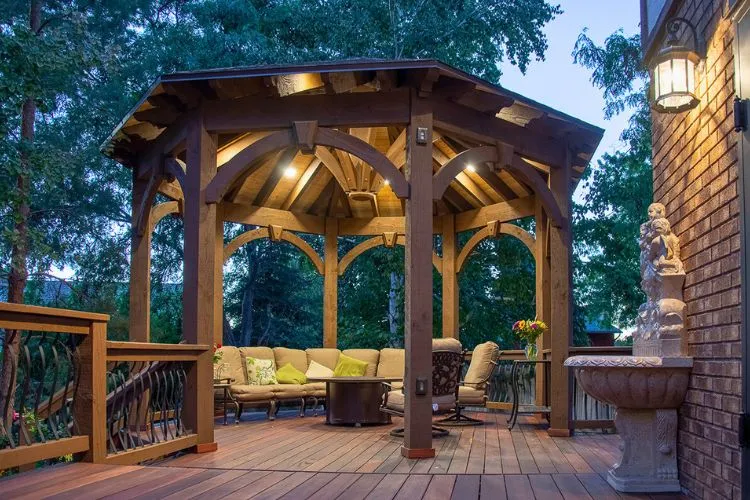
Insulating the flooring can prevent the cold from seeping up through the ground, and adding an insulated gazebo roof can dramatically increase the warmth within the structure.
Adding Enclosures
To keep the warmth locked in, enclosures are incredibly effective. Plastic sheeting offers a quick, short-term solution that still lets in light while keeping out the cold.
For a more enduring solution, glass panels can transform your gazebo into a conservatory. Both approaches help to reduce heat loss, but your choice will depend on how permanent you wish your winter-proofing to be.
How To Keep Your Gazebo Warm During Colder Weather?
Portable Heaters
For a flexible form of warmth, portable heaters are an excellent choice for gazebos. They come as electric or propane models and can be moved as needed.
When using these heaters, it’s vital to ensure they are appropriately placed to avoid any fire risk, and never leave them unattended.
Portable Heaters
A more integrated approach involves installing permanent heating systems like electric radiators or perhaps a wood-burning stove for a rustic touch.
These options require careful consideration for installation, including the need for a professional to ensure safety protocols are followed.
Fire Pits and Chimineas
A fire pit or chiminea can add both warmth and a captivating ambience to your gazebo. They must be used with caution, ensuring that there’s adequate ventilation and that no flammable materials are nearby.
Additional Warmth Options
Using Textiles
Textiles in the form of heavy drapes, rugs, and throws not only add aesthetically pleasing touches but also serve as additional insulators. When selecting textiles, opt for fabrics designed for outdoor use that will withstand the elements while supplementing your gazebo’s warmth.
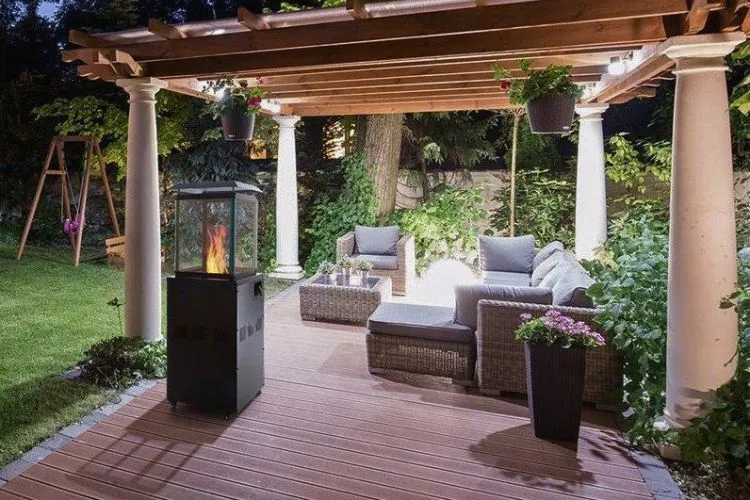
Lighting
The lighting you select can do more than just illuminate; some options can provide additional warmth. While the heat emitted from light fixtures is minimal, every bit helps, and the soft glow can make the space feel warmer visually.
Maintenance and Care
Any heating elements or enclosures you add to your gazebo will require regular maintenance to ensure they operate safely and effectively.
Before the onset of winter, perform checks on these features. This proactive approach not only enhances safety but can also extend the lifespan of your gazebo and the amenities within it.
Winterizing Your Gazebo
Preparation Steps for Colder Months
Before the cold sets in, it’s essential to get your gazebo ready for winter. Start by thoroughly cleaning the structure, removing debris and cobwebs, and cleaning the gutters to prevent water buildup.
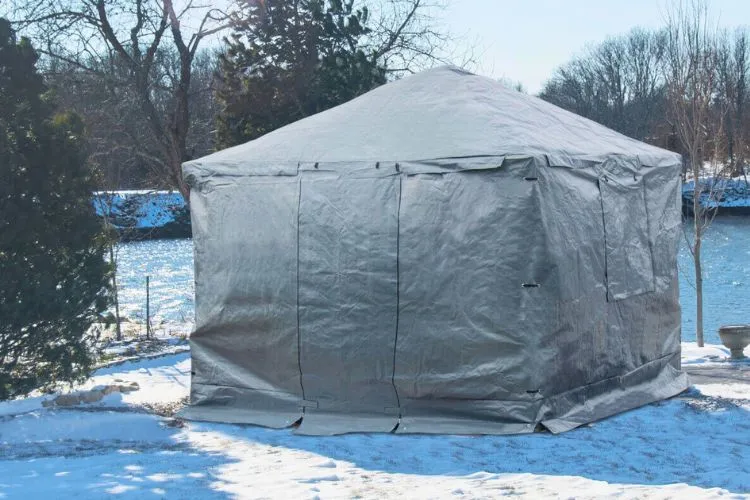
Check the entire gazebo for any cracks, gaps, or signs of damage, and seal or repair these vulnerabilities to enhance heat retention and prevent moisture ingress.
Ensure that any movable elements, such as doors or windows, fit snugly and add weather-stripping to eliminate drafts. Protective treatments or waterproofing sealants can also be applied to wooden parts to safeguard against the elements.
Insulation Techniques and Materials
For insulation, consider using thick, reflective foil-backed insulation for roofs, which not only retains heat but also reflects cold air. The walls can benefit from foam board insulation, and you can apply caulking around the edges to fortify against the chill.
Insulating the floor is equally important; consider using rigid foam insulation beneath the flooring or an outdoor-rated carpet to provide additional thermal comfort.
Quality insulation materials can make a significant impact, ensuring your gazebo is a cozy retreat even in the depths of winter.
Safety and Maintenance
Winter Safety Tips for Outdoor Heating
Safety is paramount when using heaters or fire pits in your gazebo. Always ensure there is ample space around any heating device to prevent contact with flammable materials like curtains or furniture.
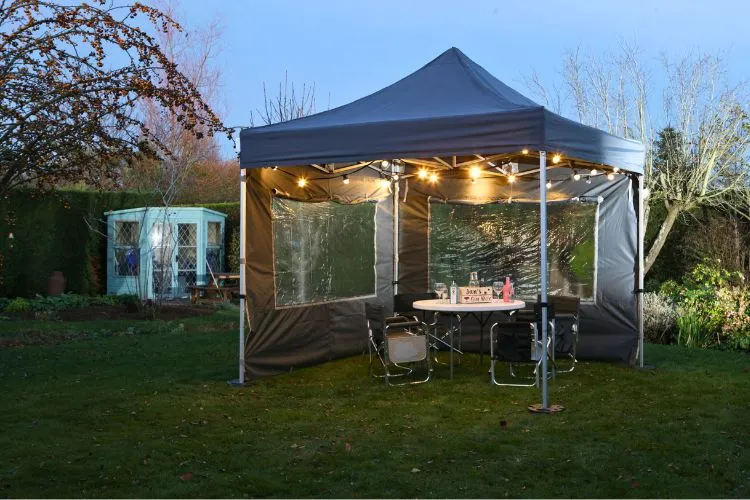
Use heaters that have automatic shut-off features and stable bases to prevent tipping. For fire pits, install a protective screen to contain any sparks and never leave the fire unattended. Check local regulations about outdoor fires and adhere strictly to safety norms.
Winter Maintenance Checklist
To keep your gazebo in prime condition during the cold months, adhere to a regular maintenance routine:
- Inspect the Roof and Flooring: Check for damages or weak spots where snow and ice can accumulate or water might seep through.
- Clean and Seal Wood Surfaces: Remove any moss or debris, and apply a fresh layer of weather-resistant sealant to protect the wood from moisture and freezing temperatures.
- Check Heating Elements: Before each use, inspect heaters or fire pits for proper functionality; ensure wires are intact and there are no gas leaks.
- Prepare for Snow: Keep pathways to and from the gazebo clear of snow and ice. Consider installing a heating cable to prevent ice dams if your gazebo has a gutter system.
Regularly following these tips will not only keep your gazebo safe but also cozy and inviting throughout the winter season.
You may also find useful: Gazebo Safety Precautions: Ultimate Guide
Frequently Asked Questions (FAQs)
How can I heat my gazebo without electricity?
Consider propane heaters or wood-burning stoves, and explore using fire pits with caution.
Are portable heaters safe to use in a gazebo?
Yes, when used correctly. Look for heaters with safety features and never leave them unattended.
Can I use my gazebo year-round, even in snow?
Yes, with proper structural considerations and efficient heating.
How do choose the right heating option for my gazebo?
Assess the gazebo’s size, your climate, and budget to select the best heating method for your needs.
Conclusion:
Transforming your gazebo into a cozy sanctuary during colder weather is not only possible, it’s a project that can bring added value to your life by maximizing the use of your outdoor space.
Experiment with a combination of methods to discover what works best for you, and don’t shy away from consulting professionals for advice or services that ensure safety and functionality.

Sergio Gomes, a passionate advocate for outdoor living and the male voice behind Shades Authority. With years of experience, Sergio is your trusted source for expert insights on gazebos, pavilions, cabanas, pergolas, and all things outdoor shade solutions. Join him on a journey to transform your outdoor spaces into stunning, functional retreats
